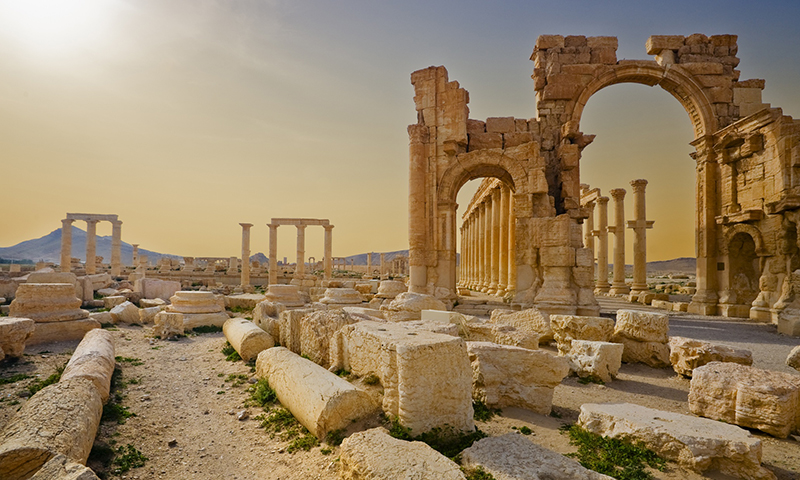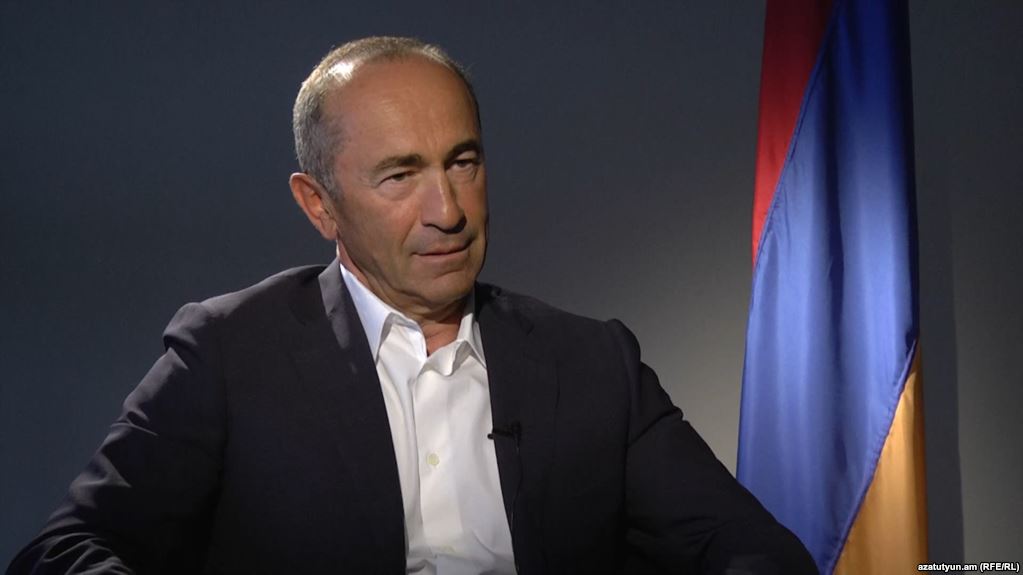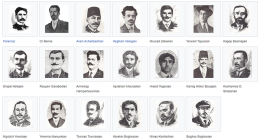BY HEGHNAR ZEITLIAN WATENPAUGH
Artifacts that have experienced atrocities, even genocide, and survived, acquire the power to recall the horrors of the past, and to recollect the absent persons, things, and places that were lost. They symbolize violence, but also survival and resilience. Material objects that have endured looting, mutilation, displacement, and separation from the communities where they functioned as sacred relics, liturgical aids, or prized artworks form a special category. They are survivor objects.
The intentional destruction of cultural heritage in peace and war, the looting of artifacts and their trafficking by criminal networks, as well as contests over the ownership, function, and meaning of art, occupy the headlines from the Middle East. Western museums display, and auction houses put up for sale, objects that were illegally excavated or unlawfully removed from places of worship, that entered circulation on the art market due to war, colonialism, civil unrest, atrocities, or sheer desperation. Taking advantage of the chaos of the invasion of Baghdad in April 2003, looters sacked the National Museum of Iraq and stole thousands of artifacts, representing millennia of ancient Iraqi history (1). The self-proclaimed Islamic State turned the destruction of art into mass spectacle. Its operatives filmed the destruction of art in the Mosul Museum and the blasting of the Temple of Bel in Palmyra, then edited the film into highly curated videos that they disseminate through the Islamic State’s sophisticated propaganda network, and that are then amplified through social media to manipulate public perception and instill outrage and terror (2). The wealthiest people in the world have resorted to opaque financial acrobatics involving offshore businesses and shell companies to conduct a semilegal or illegal trade in art that evades scrutiny and confuses restitution claims, as the Panama Papers recently revealed (3).
These assaults on cultural heritage have prompted outrage and responses from state agencies, international bodies, and experts (4). Most important and poignant have been the responses on the ground, from the “defenders of cultural heritage,” the heritage professionals, impromptu activists, and ordinary folk who sprang into action and took risks to protect cultural heritage (5). In January 2011, protestors in Tahrir Square formed a human chain to keep looters from attacking the nearby Egyptian National Museum, home to such iconic artifacts as the Mask of Tutankhamen. In Syria, archaeologists as well as private individuals continue to take enormous risks to protect cultural heritage and document the damage, sometimes using shaky cellphone cameras to take clandestine photographs.
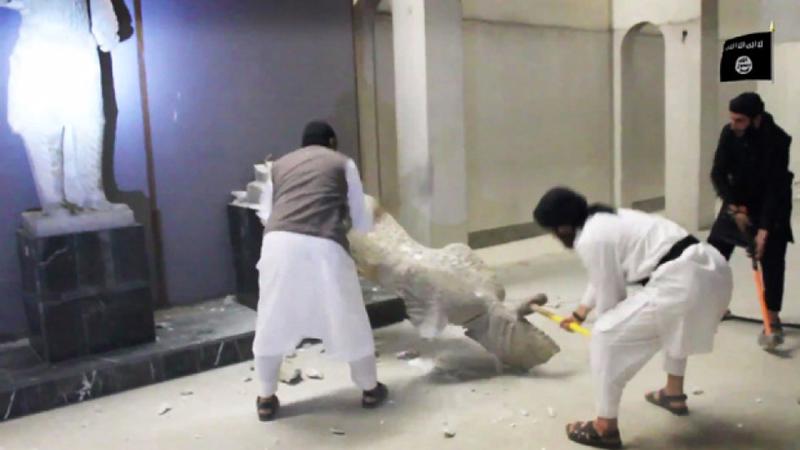

Although the recent acts of cultural destruction and looting have reverberated around the world, similar practices have a long and fraught history in the Middle East. In the past, they have been entwined with practices of colonialism, empire building, and nationalism(6). They have also intersected with the mass extermination of civilian populations by their own states—ethnic cleansing, massacre, and genocide. These episodes still cast a long shadow, not only in the Middle East but beyond, in the diasporas where children of migrants and refugees seek to remake their communities. The repercussions of assaults on cultural heritage endure in the struggles for the restitution, repatriation, and reunification of art or sacred objects with their communities or countries of origin. We not only have to come to terms with the immediate implications of the destruction of heritage that we witness in our own time, but we also have to grapple with the long-term consequences of the destruction of culture and its many afterlives. Moreover, we need to understand how the experience of looting or destruction shapes the object itself, and its role in the social world.
Accounts of the destruction of art or the restitution of cultural heritage often highlight the zealous breakers of images, opportunistic looters, daring thieves, clever accountants, courageous archeologists, dedicated journalists, honest policemen, resilient librarians, undaunted art historians, acquisitive collectors, careful curators, uncaring oligarchs, and heroic lawyers. They prompt questions such as: Who owns or should own antiquities? When is art unlawfully taken, and when should it be restituted? How should museums ethically build collections? What best serves the public good without infringing on rights?
These questions all deserve answers. Yet they leave much of the object’s story untold. A treasured artwork, the image of a deity, or a holy book is a material entity launched into a web of social relationships. When people loot an object, break it, or uproot it, these experiences affect the way an object exists in the social world, and the meaning it accrues in the minds and hearts of those who encounter it, view it, or revere it (7).
The sagas of sacred relics and coveted objects, their perilous journeys through time and space, mirror the sagas of survivors and refugees and their paths towards remaking their lives and creating new futures. When followed closely, the story of a trafficked object, and of its people, reveal much about the nature of survival and the centrality of art and cultural heritage to it. They show us at eye level the experience of art, which legal notions and treaties about the human right to culture seek to enshrine in law.
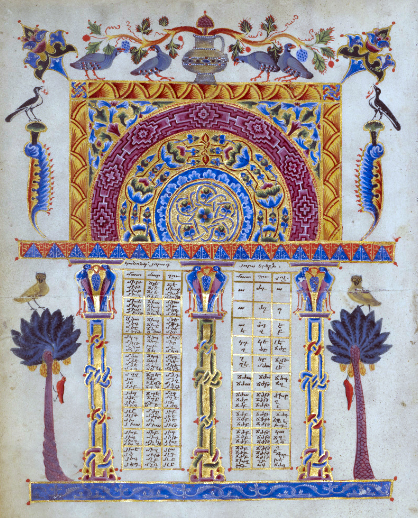

The Canon Tables, eight folios that once adorned the opening section of the Zeytun Gospels, is such an object. The Canon Tables is a medieval religious object whose life over the last century sheds light on the cultural dimension of genocide (8). This rare remnant from the lost world of Ottoman Armenians also intersected with one of the central issues of 21st-century art history: the contest between ethnic or religious communities and powerful institutions over the control of cultural patrimony.
Toros Roslin copied and illuminated the Gospels in 1256 for the Catholicos Constantine I, the head of the Armenian Church in Hromkla (Rumkale in present-day Turkey). The manuscript was taken to Zeytun, a rugged town in the Taurus Mountains (Suleymanli ¨ in present-day Turkey), after which it was later named. In Zeytun, Roslin’s Gospels were kept in a church as a revered relic and liturgical object. But the manuscript had its own agency as well, protecting the town and its people, and accomplishing miracles among the congregants. Fast forward centuries to the spring of 1915. As World War I engulfed the world, the Ottoman Empire initiated the exile and extermination of its own Armenian population, in what is now known as the Armenian Genocide. When the inhabitants of Zeytun were cast out of their homes and set upon exile where most of them would perish, the Zeytun Gospels too was taken out of its church, passed from hand to hand, and cleaved into two. Decades later, the manuscript ended up in the Mashtots Institute for Ancient Manuscripts (known as the Matenadaran) in the Republic of Armenia. However, its Canon Tables were absent. These missing pages, removed from the mother manuscript, had made their separate way to the United States. The Getty Museum acquired the Canon Tables in 1994. By that time, art historians had recognized Toros Roslin as one of the greatest artists of medieval Armenian art (9) The relic from Zeytun had become a work of art of inestimable value.
In 2010, the Western Prelacy of the Armenian Apostolic Church of America filed a lawsuit in Los Angeles County Superior Court against the J. Paul Getty Museum seeking the return of the Canon Tables, asserting that the holy pages had been stolen (10) The suit avowed that the pages had been removed from their mother manuscript, the Zeytun Gospels, as a result of the Armenian Genocide. The Church asserted the pages had been stolen, and that the Getty knew or should have known it was acquiring stolen goods. The museum’s legal counsel maintained that the Getty owned the pages as works of art, having acquired them legally, that the Canon Tables had been in the United States for more than ninety years without anyone questioning their legal status, and that the suit should be dismissed without merit.
After five years of litigation and mediation, the Western Prelacy and the Getty Museum reached a settlement. The Getty Museum acknowledged the Church’s “historical ownership” of the Canon Tables. In turn, the Church acknowledged the Getty’s decadeslong stewardship of the Canon Tables and agreed to donate the pages to the Getty “to ensure their preservation and widespread exhibition.” (11) For art professionals, the settlement constituted a successful example where thoughtful negotiation in a contest over art and a demand for restitution resulted in agreement. In our cultural landscape such contests have become common, and have helped transform museums’ acquisition practices. In such a context, the Canon Tables settlement certainly provides a precedent or model for other, similar disputes. The settlement resolved issues related to the past, but it did not result in a return to the past. The Canon Tables will not rejoin the mother manuscript. Rather, the settlement is forward-looking. The Getty committed to greater engagement with the Armenian community, both in Los Angeles and globally.
What do the lawsuit and its settlement portend for survivor objects? During and after the Armenian Genocide, just as it was cleaved into two, the Zeytun Gospels intersected with the lives of individuals who venerated it, coveted it, treasured it, saved it, lost it, remembered it, and wrote about it. Like other survivor objects, the sacred manuscript mediated the way in which individuals perceived their own identities, or reconstructed them in the wake of war, massacre, and exile. A man who narrowly survived the slaughter of his community and the burning of his neighborhood conflated his experience with the holy book’s: “The [Zeytun] Gospels . . . became an eyewitness to that terrifying massacre.” (12) A priest described the emaciated survivors and orphans of the Armenian Genocide in the shantytowns outside Aleppo in the same terms as the mutilated religious manuscripts he tried to salvage: “volumes, which, all of them, like our Armenian Nation, have been ruthlessly persecuted, cut up, violated.” (13) Yet another priest wrote of his distress at seeing a holy book he had consulted in a church treasury just before World War I suddenly appear on the art market in New York: “Now that manuscript has arrived in America as the property of a private person. . . . It has been brought here to be sold.” (14)
The experience of trauma not only transformed the object itself in its materiality— cleaving it into two, the fragment and the mother manuscript. The experience also transformed the object’s function and meaning in the world. Thus, the Zeytun Gospels as well as its Canon Tables went from being a sacred relic and liturgical object in a remote town to works of art displayed to the public in museums, their likeness endlessly reproduced through digital technology.
For every Canon Tables that survives and remakes itself in a new setting, thousands of artworks and sacred objects are destroyed or lost. As the destruction, looting, and trafficking of art continues, it is sobering to recall that for most assaults on culture, there will be no reckoning and no restitution. Despite the best efforts of defenders of cultural heritage, the good intentions of law enforcement, and the creative work of legal experts, things will not be made whole again. Survivor objects evince an intense connection to the past. Their material presence can remind and connect the viewer to absent objects and places. Survivor objects exemplify the ever-changing, dynamic nature of cultural heritage. Even objects that bear the scars of the violence committed upon them—that are fragmentary, mutilated, decayed, even illegible— symbolize resilience, and they face forward. Future viewers will read into them what they will.
NOTES
1- Many of these artifacts were later recovered. Matthew Bogdanos, “The Casualties of War: The Truth about the Iraq Museum,” American Journal of Archaeology 109 (2005): 477–526.
2- The Islamic State’s depredations in Palmyra took place in 2015. Heghnar Watenpaugh, “Cultural Heritage and the Arab Spring: War over Culture, Culture of War, and Culture War,” International Journal of Islamic Architecture 5 (2016): 245–63, with further references.
3- Scott Reyburn, “What the Panama Papers Reveal about the Art Market,” The New York Times, 11 April 2016, accessed 6 June 2017, https://nyti.ms/1Wo6d6L.
4- The 2016 report of the Special Rapporteur in the field of cultural rights, Karima Bennoune, highlights the international legal frameworks regarding the intentional destruction of culture: UN Human Rights Council, “Report of the Special Rapporteur in the Field of Cultural Rights,” 3 February 2016, A/HRC/31/59, accessed 8 June 2017, http://www.refworld.org/docid/56f174dd4.html.
5- Karima Bennoune highlighted the plight of defenders of cultural heritage who have been targeted, and argued that “defenders of cultural heritage should be recognized as cultural rights defenders and therefore as human rights defenders and that they should be afforded the rights and protections that status entails.” Ibid., p. 17, section 75.
6- Zainab Bahrani, Zeynep C¸ elik, and Edhem Eldem, eds., Scramble for the Past: A Story of Archaeology in the Ottoman Empire, 1753–1914 (Istanbul: SALT, 2011).
7- I refer here to the current art historical focus on the materiality of the object, known as the “pictorial” or “iconic” turn. See, among others, Keith Moxey, “Visual Studies and the Iconic Turn,” Journal of Visual Culture 7 (2008): 131–46; W. J. T. Mitchell, What Do Pictures Want? The Lives and Loves of Images(Chicago: University of Chicago Press, 2005); and Robin Osborne and Jeremy Tanner, eds., Art’s Agency and Art History (Malden, Mass.: Wiley-Blackwell, 2007).
8- Heghnar Zeitlian Watenpaugh, The Missing Pages: Art, Heritage and the Armenian Genocide (Stanford, Calif.: Stanford University Press, forthcoming).
9- See, among others, Sirarpie Der Nersessian, Miniature Painting in the Armenian Kingdom of Cilicia from the Twelfth to the Fourteenth Century, ed. Sylvia Agemian (Washington, D.C.: Dumbarton Oaks Research ´ Library and Collection, 1993), 1:51–76; Helen C. Evans, “Armenian Art Looks West: Toros Roslin’s Zeytun Gospels,” in Treasures in Heaven: Armenian Art, Religion, and Society, ed. Thomas F. Matthews and Roger S. Wieck (New York: Pierpont Morgan Library, 1998), 103–14.
10- Western Prelacy of the Armenian Apostolic Church of America v. The J. Paul Getty Museum, No. BC 438824 (Cal. Super. Ct. 2011).
11- J. Paul Getty Museum and the Western Prelacy of the Armenian Apostolic Church of America (21 September 2015), J. Paul Getty Museum and the Western Prelacy of the Armenian Apostolic Church of America Announce Agreement in Armenian Art Restitution Case [press release].
12- Harutiwn Ter Ghazarian is describing the night of 10 February 1920, known later as “the Battle of Marash,” in his “Letter to Archbishop A. Siwrmeian, 1 August 1936,” in Artawazd Siwrmeian, Mayr Tsutsak hayeren tseragrats S. Karasun Mankunk ekeghetsvoy Halepi, vol. 2, Mayr Tsutsak hayeren tseragrats Halepi ew Antiliasi u masnaworats (Aleppo: Tparan A. Der-Sahakian, 1936), 137.
13- The quote is excerpted from a colophon, dated 28 February 1923, which then-Bishop Babken Kiwleserian (1868–1936) added to a medieval manuscript in the Church of the Forty Martyrs in Aleppo. Published in Artawazd Siwrmeian, Nkaragir Oshin tagavori dzeragir zhamagrkin, 1319 (Antilias: Tparan Tprevanuts katoghikosutean Kilikioy, 1933), 102.
14- Garegin Hovsepian, Niwter ew usumnasirutiwnner hay aruesti ew mshakoyti patmutean, vol. 2 (New York: n.p., 1943), i.
Heghnar Zeitlian Watenpaugh is Associate Professor Department of Art and Art History, University of California, Davis, Davis, Calif.; e-mail: [email protected]

